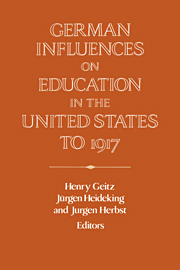Book contents
- Frontmatter
- Introduction
- PART ONE AMERICANS AND GERMANS LOOK AT EACH OTHER'S SCHOOLS
- PART TWO VARIETIES OF TEACHERS AND STYLES OF TEACHING
- PART THREE GERMAN SCHOOLS IN AMERICA
- PART FOUR THE GERMAN INFLUENCE ON HIGHER EDUCATION
- 11 American Students in Germany, 1815-1914: The Structure of German and U.S. Matriculants at Göttingen University
- 12 Philip Schaff: His Role in American Evangelical Education
- 13 German Influence on the Higher Education of American Women, 1865-1914
- 14 Basil L. Gildersleeve: The Formative Influence
- 15 A Mediator between Two Historical Worlds: Hermann Eduard von Hoist and the University of Chicago
- 16 German Influences on American Clinical Medicine, 1870-1914
- Index
11 - American Students in Germany, 1815-1914: The Structure of German and U.S. Matriculants at Göttingen University
Published online by Cambridge University Press: 05 January 2013
- Frontmatter
- Introduction
- PART ONE AMERICANS AND GERMANS LOOK AT EACH OTHER'S SCHOOLS
- PART TWO VARIETIES OF TEACHERS AND STYLES OF TEACHING
- PART THREE GERMAN SCHOOLS IN AMERICA
- PART FOUR THE GERMAN INFLUENCE ON HIGHER EDUCATION
- 11 American Students in Germany, 1815-1914: The Structure of German and U.S. Matriculants at Göttingen University
- 12 Philip Schaff: His Role in American Evangelical Education
- 13 German Influence on the Higher Education of American Women, 1865-1914
- 14 Basil L. Gildersleeve: The Formative Influence
- 15 A Mediator between Two Historical Worlds: Hermann Eduard von Hoist and the University of Chicago
- 16 German Influences on American Clinical Medicine, 1870-1914
- Index
Summary
The influence of the German university on American higher education has more often been posited than proven. To sympathetic observers like Charles Franklin Thwing, it went without saying that “the German university has helped to create and to nourish the American.” To skeptical contemporaries like F. H. Swift, imperial institutions rather exemplified “a baffling paradox of culture and brutality” whose effects on U.S. practice should be excised. This division of opinion has proven persistent. On the one hand, ethnic apologists have tended to celebrate the impact of German learning on American development, including much rhetorical praise in their efforts to revive pride in their ancestry. On the other hand, critical historians of education have resented the implication of cultural dependence and stressed native developments instead. The verdict of Laurence Veysey has become commonplace: American students “accepted the method, perhaps the vision of scholarship, but not the Qeist of German universities.” The reasons for the dispute are not only different emotional attitudes toward Central Europe, but also disagreements about the nature of the evidence and the criteria of evaluation.
- Type
- Chapter
- Information
- German Influences on Education in the United States to 1917 , pp. 195 - 212Publisher: Cambridge University PressPrint publication year: 1995
- 4
- Cited by

